
Elymus repens, commonly known as couch grass, is a very common perennial species of grass native to most of Europe, Asia, the Arctic, and northwest Africa. It has been brought into other mild northern climates for forage or erosion control, but is often considered a weed.

Aegilops is a genus of Eurasian and North American plants in the grass family, Poaceae. They are known generally as goatgrasses. Some species are known as invasive weeds in parts of North America.
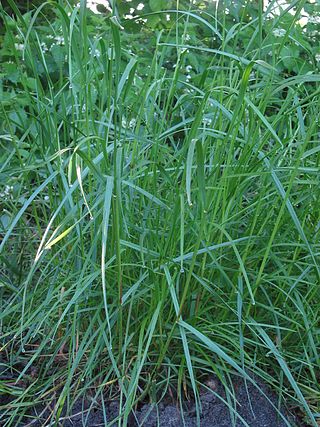
Lolium perenne, common name perennial ryegrass, English ryegrass, winter ryegrass, or ray grass, is a grass from the family Poaceae. It is native to Europe, Asia and northern Africa, but is widely cultivated and naturalised around the world.

Elymus is a genus of perennial plants with approximately 150 species in the grass family, related to rye, wheat, and other widely grown cereal grains.
Elymus californicus is a species of wild rye known by the common name California bottlebrush grass. This grass is endemic to California where it is an uncommon species known from a few counties in the San Francisco Bay Area. It grows between one and two meters in height. The tall, erect stem is nearly naked, bearing the occasional sheathing leaf with a blade 10 to 20 centimeters long. It bears an erect inflorescence which curves as it becomes heavier in grain. Each inflorescence is divided into three or four nodes with three or four spikelets per node. Each spikelet is between one and two centimeters long, not counting a long awn about two centimeters long.

Elymus canadensis, synonyms including Elymus wiegandii, commonly known as Canada wild rye or Canadian wildrye, is a species of wild rye native to much of North America. It is most abundant in the central plains and Great Plains. It grows in a number of ecosystems, including woodlands, savannas, dunes, and prairies, sometimes in areas that have been disturbed.

Elymus elymoides is a species of wild rye known by the common name squirreltail. This grass is native to central and western North America.

Elymus glaucus is a species of grass known as blue wild rye or blue wildrye. This grass is native to North America from Alaska to New York to northern Mexico. It is a common and widespread species of wild rye.

Lolium multiflorum is a ryegrass native to temperate Europe, though its precise native range is unknown.

Eriocoma latiglumis is a species of grass known by the common names wide-glumed needlegrass and Sierra needlegrass.

Eriocoma parishii is a species of grass known by the common name Parish's needlegrass.

Elymus multisetus is a species of wild rye known by the common name big squirreltail.

Elymus scribneri is a species of wild rye known by the common names spreading wheatgrass and Scribner's wheatgrass. It is native to much of the western United States and parts of central Canada where it grows in several types of habitat including alpine mountain peaks.
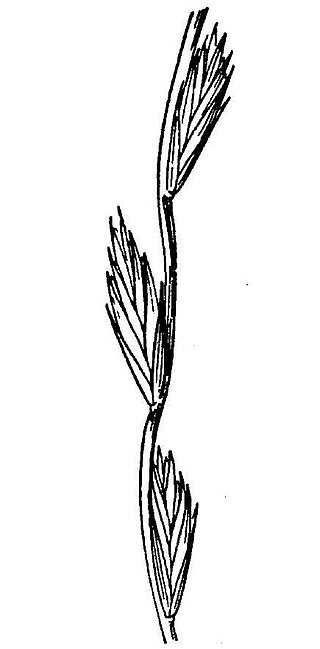
Elymus stebbinsii is a species of wild rye known by the common name Parish wheatgrass. It is endemic to California, where it grows in the forests and chaparral of many of the coastal and inland mountain ranges. It is a perennial grass growing up to 1.2 meters tall. The inflorescence is a narrow, linear series of single-spikelet nodes up to 25 centimeters long. Each spikelet is up to 2 centimeters long with a short awn of just a few millimeters.
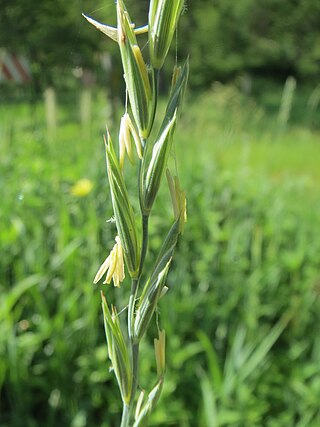
Elymus trachycaulus is a species of wild rye known by the common name slender wheatgrass. It is native to much of North America. It grows in widely varied habitats from northern Canada to Mexico, but is absent from most of the southeastern United States.

Leymus cinereus is a species of wild rye known by the common names basin wild rye, Great Basin wild rye, and Great Basin lyme grass. It is common in western North America.

Hartmaniella sierrae, commonly known as Sierra starwort, is a species of flowering plant in the family Caryophyllaceae.

Schoenoplectus tabernaemontani is a species of flowering plant in the sedge family known by the common names softstem bulrush, grey club-rush, and great bulrush. It can be found throughout much of the world; it has been reported from every state in the United States, and from every province and territory in Canada except Nunavut. It grows in moist and wet habitat, and sometimes in shallow water.
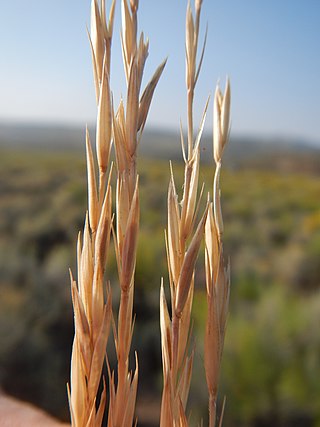
Leymus salina is a species of grass known as Salina wildrye, Salina Pass wild rye, and saline wildrye. It is native to the western United States and is named for its type locality: Salina Pass, Utah.
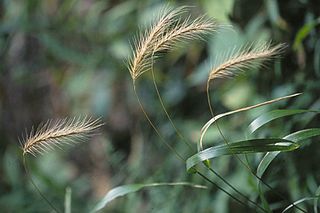
Elymus villosus is a species of wild rye known by the common names silky wild rye, downy wild rye, or hairy wild rye. It is native to eastern North America.



















